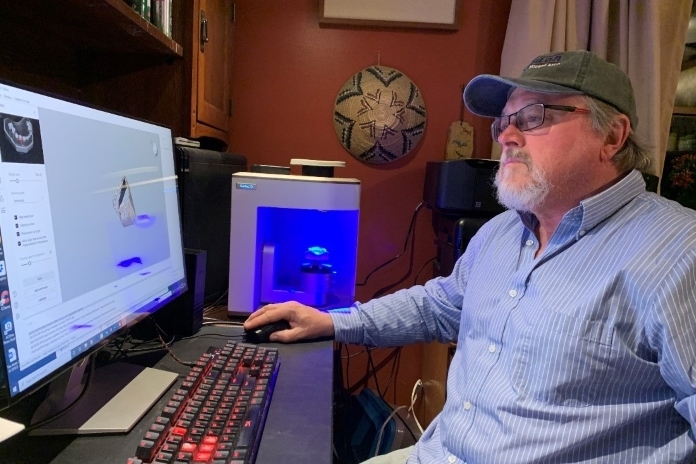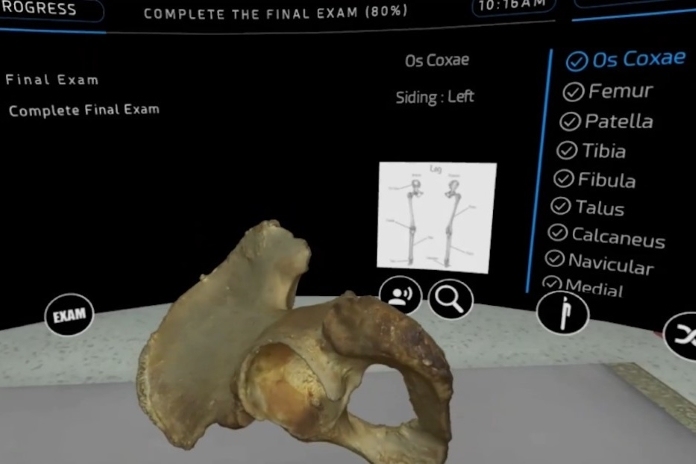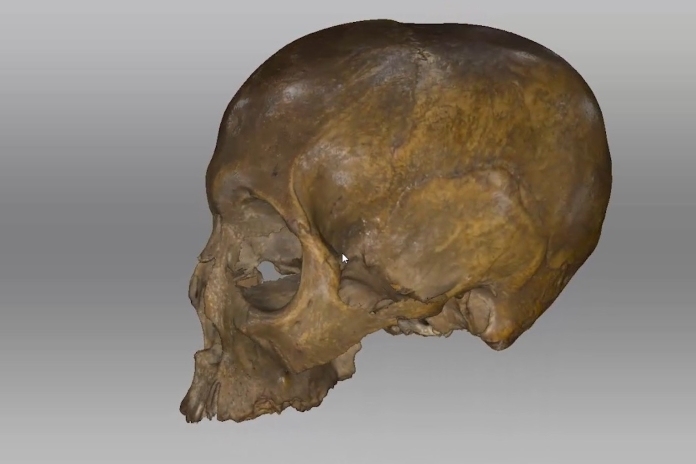Artec Micro & Space Spider help create the world’s first Virtual Reality Human Osteology course
Challenge: A renowned forensic anthropologist turned to 3D scanning when he needed to capture hundreds of bones and transform them into anatomically-precise 3D models for a groundbreaking VR course.
Solution: Artec Micro, Artec Space Spider, Artec Studio
Results: Over the course of several weeks, the desktop Artec Micro and the handheld Artec Space Spider were used to scan all the surfaces of each bone in minutes. The scans were then processed in Artec Studio and exported as high-resolution 3D models ready for VR use.

Undergraduate student Kaitlyn Schoonover using the Artec Space Spider to scan a black bear (Ursus americanus)humerus
Hours after a semi-decayed leg emerged from a river in northern California, sheriff’s deputies acted quickly. They hurried the remains to three specialists, a medical pathologist, an archaeologist, and a veterinarian. The first two believed the leg to be human, while the vet disagreed, concluding that it was non-human.
Cut marks on the bones signified that the leg had been forcefully sawn off. So, with that in mind, it was decided that the remains must be human. A search and rescue team was quickly brought together, with sheriff’s detectives and deputies all joining in. Three days of methodically combing over the surrounding riverbanks and landscapes proved fruitless. That’s when a forensic anthropologist was brought in, for a 4th opinion. Without hesitation, the leg was identified as that of a black bear, most likely discarded by a hunter somewhere upstream.
This incident highlights the crucial necessity for law enforcement officers and those working alongside them to have real-world knowledge of the human skeleton. If a forensic anthropologist or someone with similar expertise had been consulted at the outset, hundreds of labor hours and thousands of dollars in expenses would have been saved. These kinds of misidentifications happen countless times every year, across the country and globally.

Comparative 3D scans of a black bear humerus (top) and a human humerus, made using Artec Space Spider
Historically, the most practical way to gain such an in-depth understanding of the human skeleton was to attend a human osteology course at a larger university, entailing a full semester of live classes and associated laboratories with collections of real human bones. This is not always practical or even possible. Even if it were, few universities today have an adequate collection of human bones suitable for studying, and instead rely on plastic model substitutes.
Recognizing this widespread need,one of the world’s leading forensic anthropologists is using state-of-the-art 3D scanning technology and the latest in Virtual Reality (VR) to turn that paradigm upside down.Dennis C. Dirkmaat, Ph.D., is a board-certified forensic anthropologist who has been running a world-class forensic anthropology program at Mercyhurst University in Erie, Pennsylvania since 1991.
He has personally conducted close to 1000 forensic anthropology cases for nearly 100 coroners, medical examiners, and law enforcement agencies and offices across the country. He was recently honored with two major awards in his discipline, including the first ever awarded Outstanding Mentor, as well as the T. Dale Stewart Award for lifetime achievement in forensic anthropology.

Dr. Dennis Dirkmaat scanning a dental model with Artec Micro
The forensic anthropology cases that Dr. Dirkmaat has been involved in include recoveries of surface-scattered human remains, buried body features, fatal fire scenes, and even mass disaster recoveries, including United Flight 93 in Somerset, PA in September 2001, and the Colgan Air crash in Buffalo in 2009.
He also conducts large-scale searches for forensic scenes, as well as victim identification and skeletal trauma analyses. Dirkmaat has testified in court 28 times as an expert witness. Many of his former students have gone on to become medicolegal death investigators and professional forensic anthropologists running their own programs throughout the country and abroad.

The Lessons Selection page from the HD Forensics VR Human Osteology Course
With Dirkmaat’sVR Human Osteology course, anyone around the world can gain a comprehensive knowledge of the human skeleton by studying at their own pace, in a 100% distraction-free environment.
Two years in the making, the course is every bit as thorough as Dirkmaat’s 15-week in-person, university-level laboratory course for future biological anthropologists. Carefully sequenced tests during and after each lesson ensure that the material is firmly cemented into long-term memory.

A student taking the VR Human Osteology Course outdoors
Using either an Oculus Go or an Oculus Quest II VR headset, you can immersively interact with each and every one of the body’s 206 bones in high-resolution color 3D. Lesson by lesson, your osteological understanding expands incrementally in the most appropriate sequence: first you learn the names of bones, how to spell and pronounce them, understand their locations in the body, and then you learn the anatomical directional terms.
Throughout the remainder of the course, you can virtually pick up each bone, zoom in and out, examine it from every possible angle, and, at your own pace, learn each bone’s unique, identifying features.

The Bone Names lesson from the VR Human Osteology Course
According to Dirkmaat, “This course will not only be of immense benefit to individuals working in the medicolegal fields, but also to anyone considering a career in medicine, health-related sciences, sports medicine, anatomy, and the biological sciences. An unequivocal expertise in human osteology is critical to all of these disciplines and many others.”
All of the lifelike 3D models featured in the VR Human Osteology course were created from submillimeter-precise scans of real human bones. The two metrology-grade, professional 3D scanners used for capturing these bones are the handheldArtec Space Spiderand desktopArtec Micro.

Artec Micro scan of an adult first molar
Taking just minutes to capture each bone, the Space Spider was used for creating 3D models of the larger bones of the body, such as the skull and the arm and leg bones, while the Micro, which scans small objects at up to 10 microns’ accuracy, captured the smaller bones, including those of the hands and feet, as well as the vertebrae, teeth, and many others.

Graduate student Anthony Lanfranchi scanning a human sternum with Artec Space Spider
One of the designers of the course, Mercyhurst University forensic anthropology master’s student Anthony Lanfranchi, said, “A few years ago, when I first picked up our Space Spider, I’d never used a 3D scanner before. But it was very easy to learn.In the past, we documented bones through photography, by taking photos of the bones and features from various angles, and even creating dental stone casts of the most relevant features. And for actually measuring the bones, that was done with calipers and measuring tape.”
Lanfranchi continued, “But photos don’t always represent the bone well, and certain markings, colorations, or important characteristics can easily be lost in the process. When it comes to manually measuring bones, you need to make multiple, time-consuming measurements if you want acceptable results. But for optimal results? If you consider the curved, organic structures and surfaces of bones, it’s next to impossible to precisely measure these with these old technologies.”

A student taking the VR Osteology Course at her desk
“ButArtec 3D scannerscapture them perfectly, whether it’s the long, sweeping surfaces of the femur, the many threadlike sutures and deep recesses of the skull, or the really tiny bones of the hands and feet.In minutes I can teach a student new to the technology how to scan any bone or anatomical structure, and take precise measurements to below a millimeter accuracy. That’s even if you’re measuring across multiple curved surfaces. Manual measurements don’t even come close to what Artec 3D scans can deliver,” Lanfranchi emphasized.

The Feature Identification lesson of the VR Human Osteology Course; highlighting the interosseous crest of the left radius
After scanning a range of bones at the highest resolution possible, Lanfranchi processes them inArtec Studiosoftware. His workflow is simple: first click on the Lasso tool to remove any tiny bits of noise present, then use Sharp Fusion, and add on the texture. Then the scans are ready for exporting in a variety of formats. In the past, this took much longer than it does today.
In Lanfranchi’s words, “Adding texture to one of our large scans was usually the point when I got up and did another task for an hour or so, and then came back to export the scan.Now with Artec Studio 15, it takes just about 30 minutes for me to do everything, the entire scan and fully processing that scan. It truly is phenomenal.”
Lanfranchi began using the Artec Micro in early 2020. He found the automated desktop scanner both intuitive and easy to use.“After only a few hours, I worked out the best settings for capturing the small bones and teeth we have in our collection. In the weeks to come, we easily scanned over 400 elements including smaller human bones, animal bones, and an assemblage of human teeth.”

The Bone Identification lesson of the VR Human Osteology Course; depicting the left Os Coxa
In addition to their use in the VR Human Osteology course, these Micro scans, together with the Space Spider scans, are being used to create virtual courses for training medical and dental students, as well as forensic and biological anthropologists, among others.
The timing couldn’t be better. In Lanfranchi’s words, “This is extremely beneficial this year, because of Covid-19 and the restrictions in accessing human bone collections that it created for us.If it weren’t for the quick scanning abilities of the Artec Micro and Space Spider, and the fast processing of Artec Studio 15, when it comes to creating virtual human skeletal collections, there’s just no way that we could confidently transform our extensive bone collections into 3D models that are ready for VR so quickly.”

Artec Studio 15 screenshot of a raccoon (Procyon lotor) femur scanned with Artec Micro
Dirkmaat and his team are working on a range of apps that will use the Space Spider and Micro 3D models. This includes a dedicated app for law enforcement officers to help prevent misidentification of human and non-human remains by officers out in the field. The app will featurelifelike 3D modelsof human bones, for side-by-side comparisons with scale 3D models of non-human remains, including deer, bear, raccoon, cow, pig, etc.

Artec Studio 15 screenshot of a juvenile black bear astragalus (ankle bone) scanned with Artec Micro
According to Lanfranchi, “Every day around the country, police are contacting forensic anthropologists and asking them about whether the bones they found are human or not. Usually, the answer is ‘no,’ and is often accompanied with an assessment of the most likely animal that bone came from. But once officers have this app, they’ll quickly be able to see for themselves whether the bone is human or not.”
Due to the university transitioning to remote classes earlier in the year, Lanfranchi and his classmates had to take their human osteology class virtually. This meant that for the laboratory portion of the class, students had nothing more than photos of bones to refer to and study. Lanfranchi reflected on the vexing experience, “This was extremely difficult for all of us, and for some, what they learned virtually failed to carry over to the real bones when we finally returned back to the lab with the collections.”

A human cranium, scanned with Artec Space Spider, processed in Artec Studio
Lanfranchi underscored the importance of3D scanningin forensics education, saying “In more than a few forensics courses around the country, even during non-pandemic times, rather than working directly with bones, students are simply given textbooks with photos of bones.I have no doubt in my mind that 3D scans like those from Space Spider and Micro are a much better learning tool than flat photographs on a page. I would even say that such scans, as experienced in a VR course like ours, will work just as good as, if not better than, studying the real bones themselves.You are not restricted by limited laboratory hours. You get to work at your own pace, for as long as you want or need.”
Lanfranchi went on, “Because with the VR course, you have your very own set of bones available to you 24/7, and you can examine them as much as you’d like. There’s no risk of damage to the bones. And you’re being taught by a master teacher who knows how the human skeleton is best learned. Dr. Dirkmaat put the course together using the most effective sequences of lessons. That right there is priceless.”
Scanners behind the story
Try out the world's leading handheld 3D scanners.





